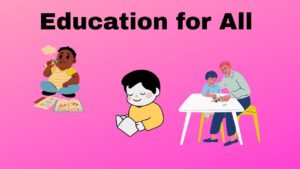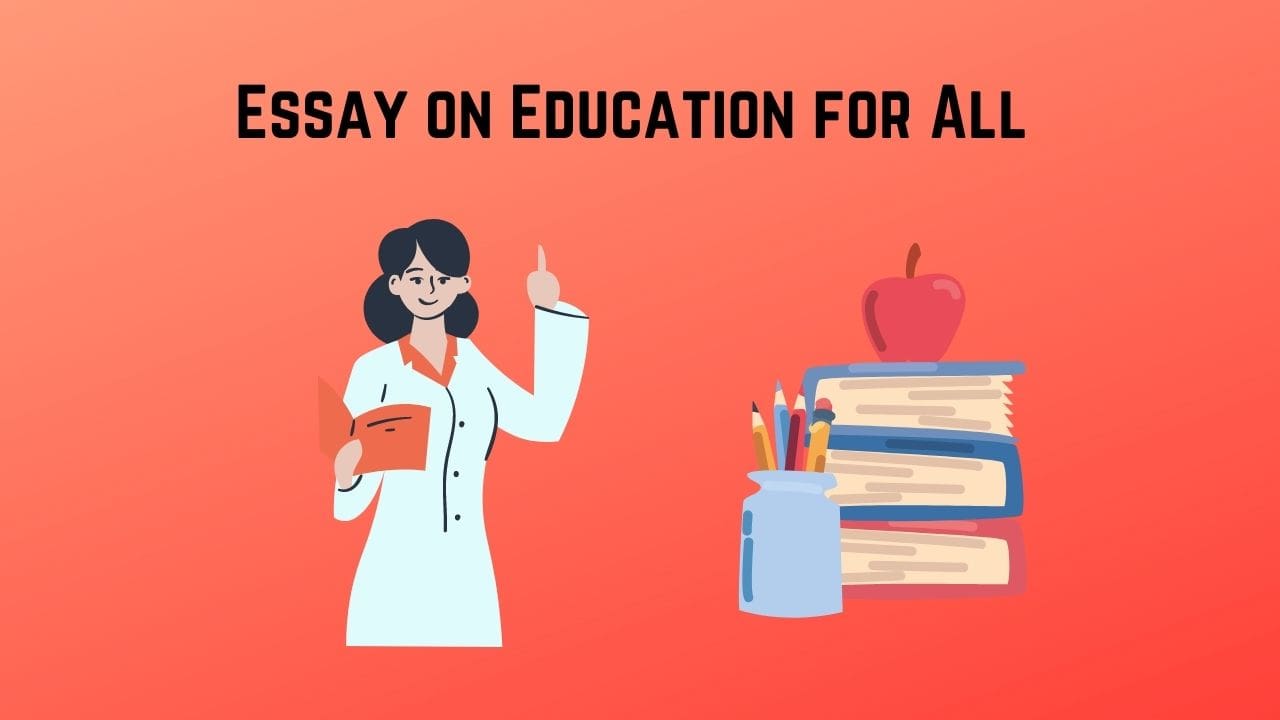Hi Everyone, Welcome To the CBSE Digital Edu Blog Website. Today We Are Going To Discuss A Interesting Topic about Essay on Education for All or Sarva Shiksha Abhiyan Essay in English. In this article, we discuss all important information regarding Essay on Education for All.
Table of Contents
Essay on Education for All in English 1000 Words
This long Essay on Education for All or Essay on Sarva Shiksha Abhiyan is beneficial for School Students of Classes 6, 7, 8, 9, 10, 11, 12, Competition Aspirant (SSC CGL CHSL MTS), and UPSC Exam.
Introduction
The Hindi meaning of “Education for All” is Sarva Shiksha Abhiyan. Education for all is a noble idea. But care has to be taken that it just does not end as an empty slogan likes “Garibi Hatao”.
Now, in some states, Panchayats have been given great powers in the matter of education and health, for which funds are made available to them. If their work is not found satisfactory i.e not showing good results then they can appoint teachers or remove them.
In this context, a state education minister said that village development committees would be formed in which two members of the village panchayat, women and retired teachers would be included. The committee will decide how to spend the money.
The expenditure will have to be done on government lines and it will be audited. There was a plan to go for universal education. No child will remain illiterate. Slums will also be covered. The government had asked the slum dwellers to arrange a room where a teacher would be provided. He said that the government is planning to provide cooked food to the students.

Our constitution lays great emphasis on primary education, which has now been made a fundamental right. Now, it is mandatory for the government to provide free primary education to all children up to the age of 14 years in India. This question of universal primary education has indeed been raised at the international level.
Additional support for Universalization of Elementary Education (UEE). It is a clear manifestation of the lack of political will to re-prioritize the economy in favor of India’s estimated 47 million children who do not attend school. No one is ready to worry about them honestly except on papers.
The Sarva Shiksha Abhiyan is the aims of providing education to all the children equally by rising above social, religious, cultural, economic, etc. All the states and union territories are covered under this campaign and an estimated 19.4 crore children are covered in 1203 lakh habitations of the country. Sarva Shiksha Abhiyan is one of the important programs in the education sector of India.
The objective of this ambitious program launched by the Government of India in the year 2000-01 is to ensure universal access to education up to the elementary level and to remove the gender gap.
Objectives of Education for All
- To achieve the goal of universalization of elementary education within a given time period. All children should complete 5 years of primary education by 2007 and 8 years of schooling by 2010.
- To keep all children in school by the year 2010.
- To remove the gap between boy and girl and social category in elementary education with universal access.
- To improve the quality of learning.
- Opening of new schools and alternative school facilities; Such as the construction of additional classrooms in schools, providing toilet and drinking water facilities, distribution of free textbooks and school dress, etc.
Strategies of Education for All
To achieve these goals, such strategies have been formulated, in which local community groups and institutional capacity building has been actively involved in the establishment of block-level resource centers. The provision of incentives like the appointment of teachers, their training, motivating parents and children, scholarships, uniforms, textbooks have been included in the framework of this campaign.
For the implementation of Sarva Shiksha Abhiyan, there is a State Project Office in each State/UT. There are District Project Offices in the district and Block Resource Centers at the block level.
The Central Government provides 100% amount for Sarva Shiksha Abhiyan to the Union Territories from the year 2015-16. The budgetary share of the Center and the states is found in the form of 90:10 in the North-East and the states of Jammu and Kashmir, Uttarakhand and Himachal Pradesh, and 60:40 in other states.
Thus, as a result of Sarva Shiksha Abhiyan, success has been achieved in bringing down the number of children dropping out of school, but the target of Sarva Shiksha Abhiyan could not be fulfilled till the year 2010.
For this, the unequal distribution of state resources and the lack of necessary human resources were considered particularly responsible, so the Central Government implemented the Right to Education Act in 2010 with the objectives of making Sarva Shiksha Abhiyan more effective.
Supreme Court Judgements
The Supreme Court in one of its judgments has said that the government has the power to regulate the fee structure of unaided private schools in the capital. The apex court ordered that government schools that have been allotted land at concessional rates, will have to comply with the conditions related to the allotment of land.
Under the condition of land allotment, private schools were to admit 25 percent of students from weaker sections of society. Schools were not asked to comply with these conditions within three months.
The court directed all the unaided schools in the capital to file their financial accounts with the Director of Education. These accounts should include details of total fees collected from students, expenses on various items including benefits, salaries, provident funds, gratuity, and other surplus funds.
An important clause in the judgment was that the school could not transfer the money generated by it to the parent institution that managed the school. Until now, the members of the managing committee used to channel the extra money into their own business or start another school, which was again run on commercial lines.
This was an important decision in the field of education. Now, children from weaker sections of society who could not afford huge donations and fees could also have some hope of getting an education along with the students from the upper classes of the society.
Conclusion
Nelson Mandela, former President of South Africa and Nobel laureate, says – “Education is the most powerful weapon, we can use it to change the world.”
Education alone separates man from other creatures of the world and makes him capable of living life as a superior and social creature, in its absence not only the development of the society but the development of the whole country gets blocked.
The World Bank has called Sarva Shiksha Abhiyan the most successful program in the world which ensures inclusive, equitable, quality education.
Suggested Article:
- Essay on New National Education Policy 2020
- Essay on Coronavirus Pandemic
- Essay on Black Money in English
I hope you like this article about Essay on Education for All. If you want to ask any queries regarding the Essay on Education for All in English 1000 Words, then message us in the comment section, and we will reply to you soon. Share this long Essay on Education for All with your friends.
